| 201 series | |
|---|---|
 A 201 series train in November 2023 A 201 series train in November 2023 | |
| In service | 1979–present |
| Manufacturer | Hitachi, Kawasaki Heavy Industries, Kinki Sharyo, Nippon Sharyo, Tokyu Car Corporation |
| Replaced | 101 series 103 series |
| Constructed | 1979 (201-900 series prototype) 1981–1985 |
| Entered service | 20 August 1979 |
| Refurbished | 2003–2007 (JR-West) |
| Number built | 1,018 vehicles |
| Number in service | 132 vehicles |
| Number preserved | 1 vehicle |
| Number scrapped | 885 vehicles |
| Successor | E231 series, E233 series, 321 series, 323 series |
| Operators | |
| Depots | Morinomiya Nara |
| Lines served | Yamatoji Line, Sakurai Line, Wakayama Line, Osaka Higashi Line |
| Specifications | |
| Car body construction | Steel |
| Car length | 20 m (65 ft 7 in) |
| Maximum speed | 100 km/h (62 mph) (service) 110 km/h (68 mph) (design speed) |
| Traction system | Thyristor chopper |
| Traction motors | MT60 (150kW) |
| Acceleration | 2.5 km/(h⋅s) (1.6 mph/s) |
| Deceleration | 3.5 km/(h⋅s) (2.2 mph/s) |
| Electric system(s) | 1,500 V DC overhead |
| Current collector(s) | PS21 diamond-shaped pantograph |
| Braking system(s) | Regenerative brake, electro-pneumatic brake |
| Safety system(s) | ATS-S, ATS-SN, ATS-SW, ATS-B, ATS-P |
| Track gauge | 1,067 mm (3 ft 6 in) |
The 201 series (201系, 201-kei) is a DC electric multiple unit (EMU) commuter train type introduced in 1979 by Japanese National Railways (JNR). It has been operated by West Japan Railway Company (JR-West) since 1987, and was formerly operated by East Japan Railway Company (JR East) from 1987 until 20 June 2011.
It was the first JNR train to use electronic chopper control.
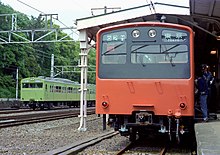
Operations
The 201 series stock has been used on a large number of lines.
JR-West
- Kansai Main Line (Yamatoji Line), Sakurai Line (Manyo Mahoroba Line), Wakayama Line (from 2006)
Former operations
JR-West
- Tokaido Main Line, Sanyo Main Line (Biwako Line, JR Kyoto Line, JR Kobe Line) (Kusatsu – Kakogawa) (from 1983 to 2007)
- Kosei Line (from 1997 to 2007, 2018 )
- Fukuchiyama Line (JR Takarazuka Line) (from 1997 to 2007)
- Osaka Loop Line (from 2005 to 7 June 2019)
- Sakurajima Line (JR Yumesaki Line) (from 2005 to 2019)
- Osaka Higashi Line (from 2008 to 11 March 2022)
-
 201 series on JR Kyoto Line service in August 2004
201 series on JR Kyoto Line service in August 2004
-
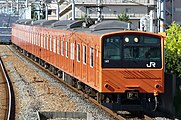 Osaka Loop Line 201 series refurbished train in September 2017
Osaka Loop Line 201 series refurbished train in September 2017
-
 Yamatoji Line 201 series refurbished train in March 2016
Yamatoji Line 201 series refurbished train in March 2016
-
 Refurbished interior in December 2021
Refurbished interior in December 2021
-
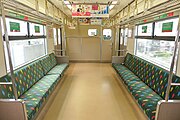 Refurbished priority seats view in December 2021
Refurbished priority seats view in December 2021
JR East
- Chūō Rapid Line (10 cars) (from 1979 to October 2010)
- Chūō-Sōbu Line (10 cars) (from 1982 to 2001)
- Ōme Line (4 cars) (from 1999 to 2008)
- Itsukaichi Line (6 cars) (from 1999 to 2008)
- Hachikō Line (6+4 cars)(Hachiōji – Komagawa, until March 2008)
- Keiyō Line, Sotobō Line, Tōgane Line (10 cars) (from 2000 to 20 June 2011)
- Musashino Line (6 cars) (from 3 March 1986 to November 1996)
-
 A Chuo/Ōme Line 201 series in June 2006
A Chuo/Ōme Line 201 series in June 2006
-
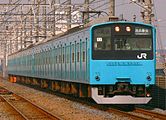 A Keiyo Line 201 series in February 2007
A Keiyo Line 201 series in February 2007
-
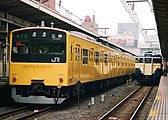 A Chūō-Sōbu Line 201 series in December 1998
A Chūō-Sōbu Line 201 series in December 1998
-
 Interior view in October 2007
Interior view in October 2007
Shikisai train
A 4-car 201 series set (W1) was modified in 2001 by JR East to become the special Shikisai (四季彩) tourist train, entering service on the Ōme Line from 4 August 2001. This train featured panorama windows and transverse seating bays on one side of the train only. It was repainted into a new livery in June 2005. The train was withdrawn from regular service at the end of June 2009, with a number of special finale runs scheduled for July.
-
 Shikisai train in original livery in May 2004
Shikisai train in original livery in May 2004
-
Shikisai train in revised livery (and windows) in June 2007
-
 Interior view in November 2008
Interior view in November 2008
Preserved examples
- KuHa 201-1: preserved at Toyoda Depot
Accidents
On the evening of 12 October 1997, A 6-car Chuo Line 201 series trainset collided with a 12-car Super Azusa E351 series train which was passing through the Otsuki Station with a 2-minute delay at a running speed of 105 km/h (65 mph), while on the right side which is a damaged 201 series trainset which collided at a speed of 25 km/h (16 mph), the Super Azusa train derailed which has been led to decoupling of 4 cars (Car No. 5 to 9), while the last which had been rolled over to the ground. The accident resulted in 78 injuries but no recorded deaths. The main cause of this accident was about the shunting or decoupling of the two 201 series trainsets which was composed of 4 cars for Ome Line & 6 cars for Chuo Line Rapid, the 4-car set remained in Otsuki, while the 6-car set was leaving from the station for turnover, but unfortunately, there was a delayed Super Azusa train which was coming behind to the main line, resulting in collision.
After this incident, the management of JR East decided to abolish the shunting work that is required the existing ATS to be turned off, and they completely repaired the damanged trainset to let them back from service.
References
- JR全車両ハンドブック2006 [JR Rolling Stock Handbook 2006]. Japan: Neko Publishing. 2006.
- "201系四半世紀の歩み". Japan Railfan Magazine. 45 (526). February 2005.
- "おおさか東線で221系の運用開始" [221 series starts operation on the Osaka Higashi Line]. Japan Railfan Magazine Online (in Japanese). Japan: Koyusha Co., Ltd. 12 March 2022. Retrieved 23 April 2024.
- JR East news release: "「さよなら中央線201系」キャンペーン<第2弾>を開催します" (25 February 2010). Retrieved 17 June 2010. (in Japanese)
- 京葉線の201系が定期運用を終える [Keiyō Line 201 series withdrawn from regular service]. Japan Railfan Magazine Online (in Japanese). Japan: Koyusha Co., Ltd. 21 June 2011. Retrieved 21 June 2011.
- JR電車編成表 2009夏 [JR EMU Formations – Summer 2009]. Japan: JRR. June 2009. ISBN 978-4-330-06909-8.
- Japan Railfan Magazine: "201系「四季彩」,青梅線定期運用を終了" (28 June 2009) Archived 30 June 2009 at the Wayback Machine. Retrieved on 28 June 2009. (in Japanese)
- "12月18日開催 JR東日本八王子支社「豊田車両センター201系展示撮影会」の参加者募集". Japan Railfan Magazine Online (in Japanese). Japan: Koyusha Co., Ltd. 8 December 2021. Archived from the original on 10 December 2021. Retrieved 10 December 2021.
- "怒り抑え代替バスへ 朝の足奪われ混乱 大月の列車衝突事故". 朝日新聞・朝刊・山梨. 14 October 1997.
JR東日本は十三日の始発から、甲府 – 塩山、塩山 – 甲斐大和、四方津 – 高尾間でそれぞれ折り返し運転した。塩山 – 四方津間は七十二台の代替バスを走らせたが、...
– 聞蔵IIビジュアルにて閲覧:負傷者の詳細についても記載がある。 - 災害情報センター・日外アソシエーツ, ed. (2007). 鉄道・航空機事故全史. 日外アソシエーツ. p. 10. ISBN 978-4-8169-2043-1.
External links
- "JR East 201 series". jreast.co.jp (in Japanese). Archived from the original on 15 January 2008. Retrieved 21 January 2008.
| DC commuter/suburban |  | |
|---|---|---|
| DC express/limited express | ||
| AC/DC commuter/suburban | ||
| AC/DC express/limited express | ||
| AC commuter/suburban | ||
| AC limited express | ||
| Non-revenue/experimental | ||
| This list shows all JNR EMUs, both active and withdrawn. Shinkansen types are omitted. | ||
| Current / active |
| ||||||||||||||||||||||||||||||||||||||||||||||||||||||||
|---|---|---|---|---|---|---|---|---|---|---|---|---|---|---|---|---|---|---|---|---|---|---|---|---|---|---|---|---|---|---|---|---|---|---|---|---|---|---|---|---|---|---|---|---|---|---|---|---|---|---|---|---|---|---|---|---|---|
| Future |
| ||||||||||||||||||||||||||||||||||||||||||||||||||||||||
| Retired / withdrawn |
| ||||||||||||||||||||||||||||||||||||||||||||||||||||||||
| Experimental | |||||||||||||||||||||||||||||||||||||||||||||||||||||||||
| Current / active |
| ||||||||||||||||||||||||||||||||||
|---|---|---|---|---|---|---|---|---|---|---|---|---|---|---|---|---|---|---|---|---|---|---|---|---|---|---|---|---|---|---|---|---|---|---|---|
| Retired / withdrawn |
| ||||||||||||||||||||||||||||||||||
- Japanese National Railways
- East Japan Railway Company
- West Japan Railway Company
- Electric multiple units of Japan
- Train-related introductions in 1979
- Hitachi multiple units
- Kawasaki multiple units
- 1500 V DC multiple units of Japan
- Nippon Sharyo multiple units
- Kinki Sharyo multiple units
- Tokyu Car multiple units
